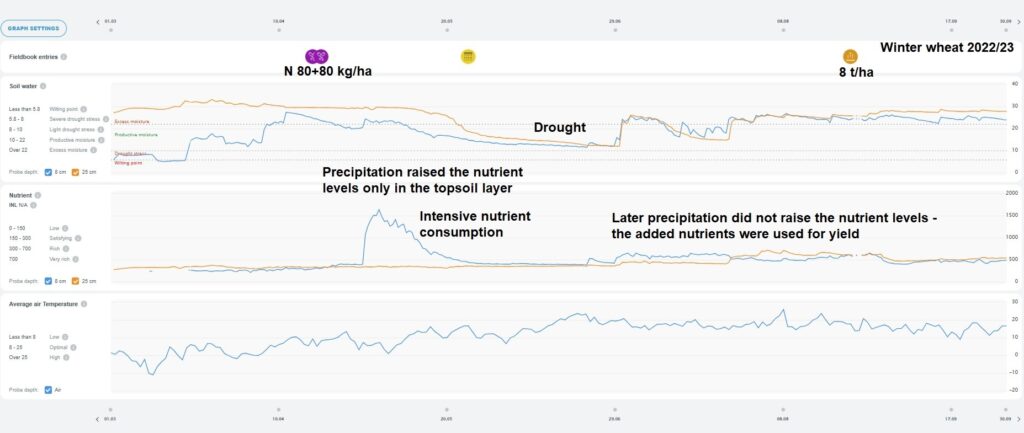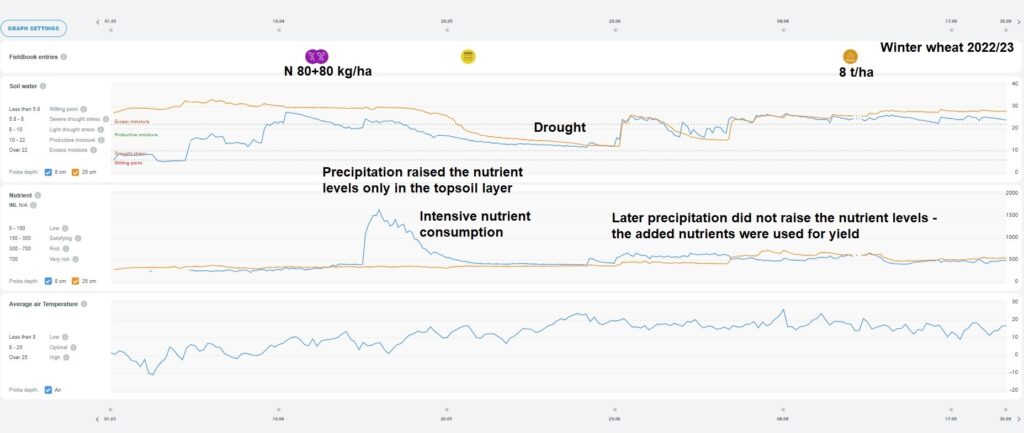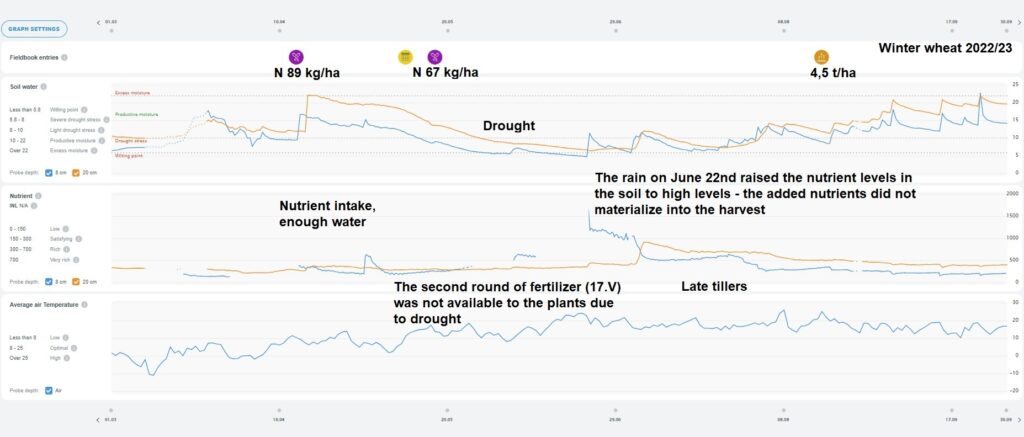
Paul-Tech’s soil sensors indicate that in most years, the problem for farmers has been spring drought. In 2023, this lasted in several places until the end of June, and in 2024 until the end of May. This is the period of intensive nutrient uptake by plants. At the beginning of plant growth, there is a reserve of soil water left over from winter, but later the soil dries out and there is a lack of rainfall to carry nutrients to the root zone. According to the Meteorological Service, the months with the lowest average rainfall during the growing season are April (34 mm) and May (42 mm). This situation leads farmers to consider the effectiveness of split fertilisation, as without rainfall, the nutrients applied to the field cannot move to the plants’ roots. Later rainfall, however, makes nutrients available at a time when they are not needed and can damage the crop.
But what really happens to nitrogen when it is applied all at once in a dry spring? Figure 1 shows a winter wheat field from 2022/23 where all the nutrients, 160 kg/ha of nitrogen, were applied to the field at once at the beginning of the growing season. The soil sensors were located in leached gley soil, medium loam, at depths of 8 and 25 cm.
Fertilisers were sown in the field by 20th April, when plant growth had already begun. Due to the moist and warm soil, the nutrients were able to dissolve immediately to support plant growth. However, the rainfall at the end of April carried the nutrients deeper into the soil. The nutrient level in the 8 cm soil layer rose very high, but nutrients were not carried to the 25 cm depth. Intensive nutrient consumption continued until the end of May, despite the lack of rainfall. Rainfall that affected the 8 cm soil layer only came around Midsummer’s Day. Water only reached the 25 cm depth on the last day of June. However, the heavy rainfall at the beginning of July no longer resulted in an increase in nutrients, indicating that the added nutrients had been used up by that time. No late tillers could form, and the yield, despite the dry June, was 8 t/ha.

Figure 2 shows the split fertilisation of winter wheat in 2022/23. The soil sensors were located in gleyed leached soil, light loam, at depths of 8 and 20 cm.
The first spring fertilisation, 89 kg/ha of nitrogen, was carried out on 14th April, when the vegetation had started to grow. The fertiliser was applied to moist soil, and the dissolving conditions were good. The rain at the end of April brought out the dissolved nutrients and allowed the plants to consume them intensively. However, the nutrients only lasted until 5th May.
The second fertilisation, 67 kg/ha of nitrogen, was carried out on 17th May, when the weather forecast predicted rain. However, the rain was modest, the fertiliser did not reach the 8 cm depth, and the drought continued until the solstice. The rain on 22nd June raised the nutrient level at the 8 cm depth very high, indicating that the second round of fertiliser had not been consumed previously. By 5th July, the nutrients, along with water, had also reached the 20 cm depth layer, where they had been washed down from the upper layer. There were plenty of nutrients to form late tillers. The yield was 4.5 t/ha.
Almost the same amount of fertiliser was used in both variants, but the yield was 3.5 t/ha lower with split application. The second round of fertiliser played a negative role in yield formation due to the drought – it did not increase the yield, it only created a large number of late tillers. With split fertilisation, a ten-day period before the second fertilisation, when there was still productive water in the soil but no nutrients, was missed in the plants’ nutrition.

The same problem was analysed more than 40 years ago by agricultural scientists and agrochemists A. Sirendi and E. Raudväli, who wrote the following in articles dealing with the use of mineral fertilisers:
“Applying fertilisers to an area where they are poorly or belatedly available to plants is essentially an uneconomical use of fertilisers. Applying fertilisers to the top 0-5 cm layer of soil disrupts the normal nutritional regime of plants in a dry spring, and during the period of intensive nutrient uptake (June), the top layer of soil is often parched, and due to the difference in osmotic pressure and the capillary rise of water on the soil surface, the concentration of fertilisers is toxically high, while in the depth of the plant roots it is too low. Later rains do carry the fertilisers deeper, but the delay in nutrient uptake causes late tillers, complicates harvesting and reduces the effectiveness of the fertilisers.
Soil is a buffer system for all compounds that enter the soil. The buffering capacity is manifested through the biological activity and physicochemical absorption of the soil. Potassium and ammonium ions are fixed in the soil by clay minerals. As a result, the entire growing season’s requirement of nitrogen and potassium can be applied to the soil at once for the plants.
The early spring use of nitrogen fertilisers before the start of the growing season is not justified in any way. In many cases, nitrogen applied to frozen ground in early spring disappears without a trace, as if it had not been applied at all. The reason for such loss of nitrogen is theoretically quite explainable. Namely, at low temperatures in early spring, dissimilative denitrification occurs, according to the following scheme:
2NO3→ 2N02 →2(HNO) →H2N2O2 → N2O↑ and N2↑
At temperatures above +7 °C, assimilative denitrification processes dominate, the end product of which, NH3, is bound by the soil. From this, we can draw a practical conclusion: We sow nitrogen fertilisers under the pre-sowing cultivation for spring crops, but for winter crops and grasses after the start of vegetation, when the soil moisture regime allows nitrogen fertiliser to be sown without damaging the turf or shoots. At this time, we give the entire nitrogen rate to cereals, but only the amount needed for the first cut to grasses.
Does split fertilisation actually increase yield in dry years — or can it reduce it? Split application of nitrogen fertilisers to cereals does not usually increase the grain yield. To some extent, only the content of nitrogen compounds in the grains may increase. However, later application of nitrogen fertilisers during stem extension or heading can cause the formation of late tillers, which impairs harvesting. Later application of nitrogen fertilisers is justified if it was not possible to give a sufficient amount in time. Then it is advisable to give it extra-radically with chemical weed control.”
Bibliography
Sirendi, A., Raudväli, E. 1983, On the losses of mineral fertilisers. Tallinn, 16 pp.
Sirendi, A. 1983, Agroecological criteria for the use of mineral fertilisers. Scientific achievements and advanced experiences in agriculture 31/1983. Tallinn, pp. 31-36.
Raudväli, E., Sirendi, A. 1983, Topical issues of nitrogen nutrition. Scientific achievements and advanced experiences in agriculture 31/1983. Tallinn, pp. 36-43.


